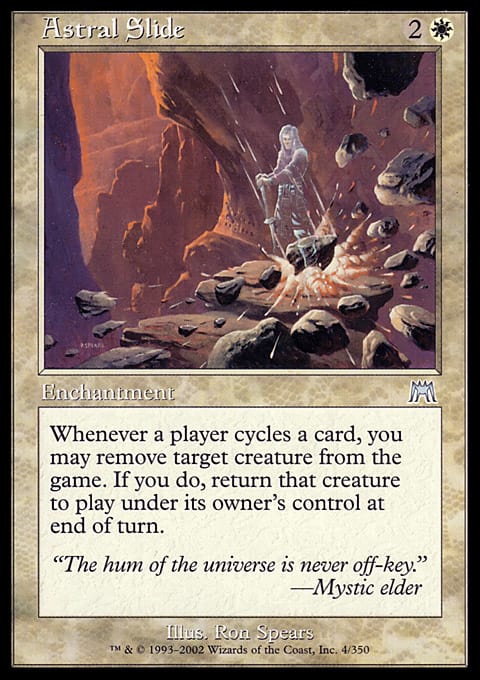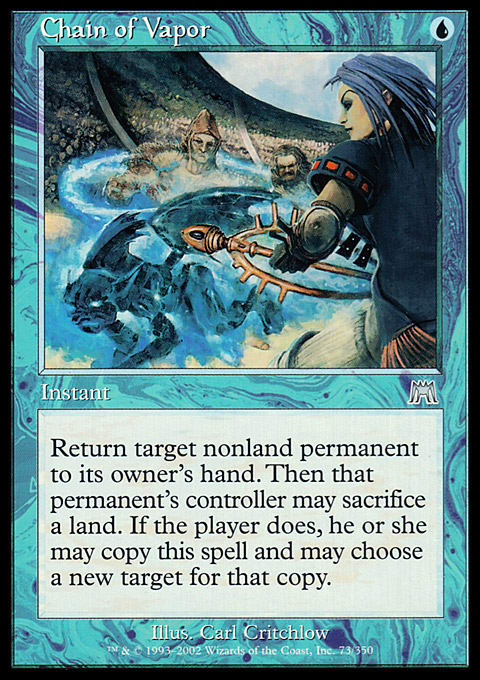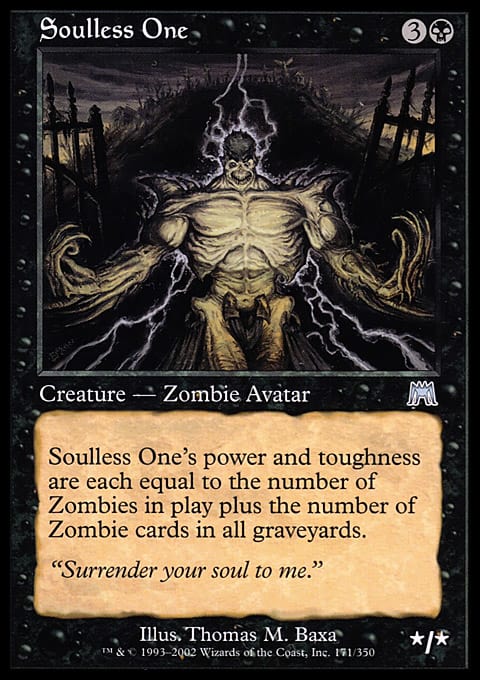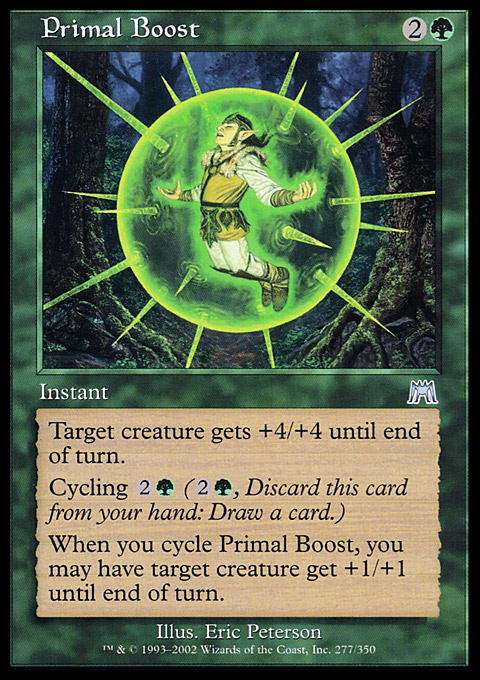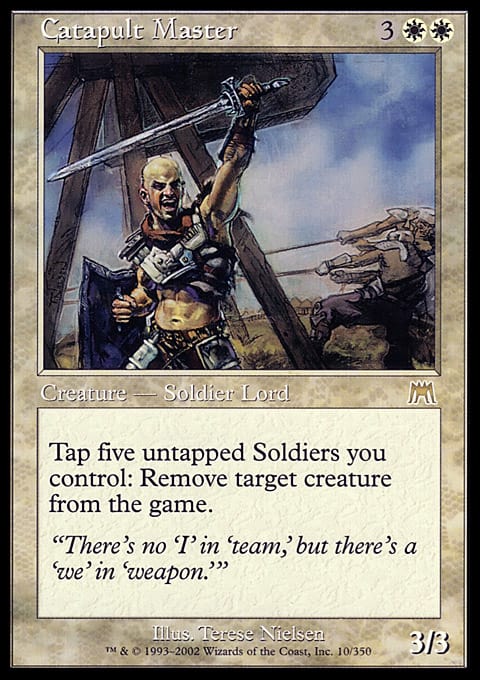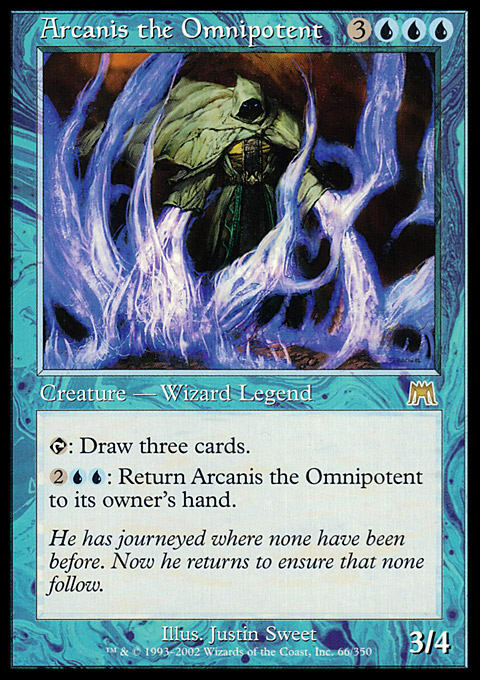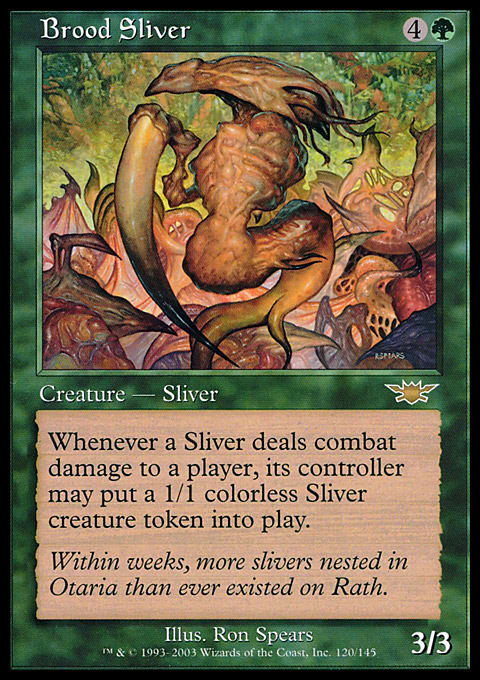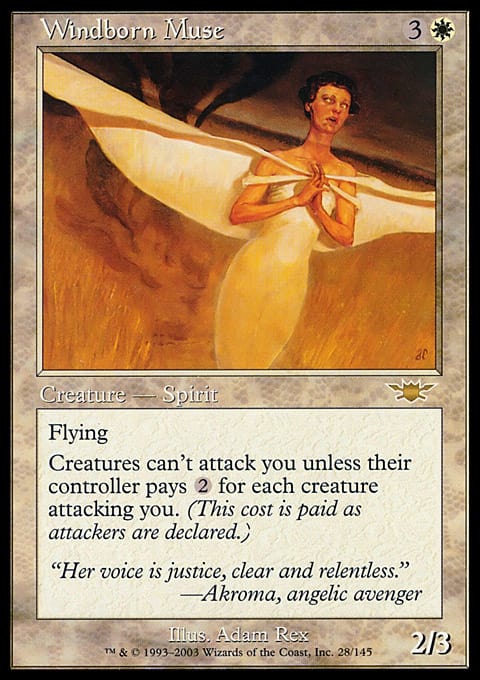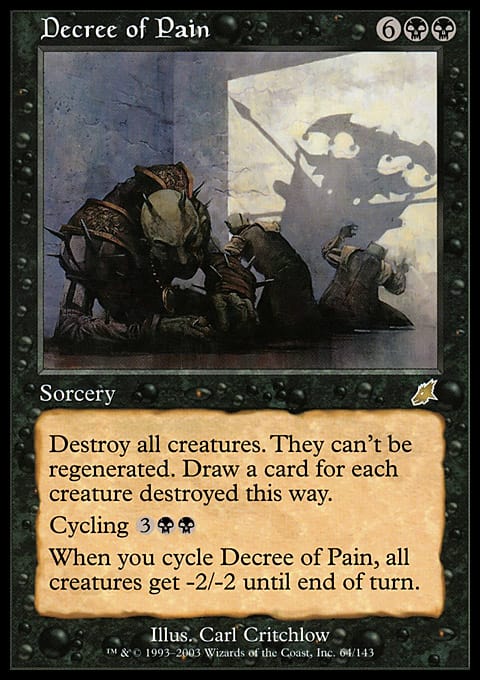I started playing in Onslaught. Magic history has made Onslaught the ’tweener block. It’s the last one block with the old card face, and it’s the last block before Modern. It had some fantastic themes and big, huge creatures, and quite a few of them were good in Standard, but later creatures largely have outclassed Onslaught’s movers and shakers.
This leaves Goblins, some Elves, storm, and fetch lands as primary remembrances from the block, obscuring how many big, stompy things were intended to be awesome (and they still are in casual). I love playing R/G Beasts of that era (Contested Cliffs and amplify are where it’s at, y’all), and my Lady Evangela Commander deck is an overgrown version of the Ivory Doom preconstruct (W/B Clerics and Zombies), so this is the first article of the series with full-on nostalgia value for me.
A reminder of the parameters:
- I’m looking at horizontal cycles (Titans), not vertical cycles (Penumbra Bobcat/Kavu/Wurm). They need at least five cards, though they don’t have to be in five colors.
- No all-common cycles. They tend to be boring.
- No land/mana cycles. They tend to be too similar for my purposes. Besides, every dual land is good.
I’m grading each cycle on three categories:
- Playability – Does this cycle have any cards people want to play?
- Depth – Was it hit-and-miss or strong overall?
- Resonance – Memorable cycles should be able to pass the flavor test, although some cycles are mechanical and are not intended to have shared flavor. Still, making all the cards cost the same, have similar names, or share other characteristics can make a cycle memorable when it otherwise wouldn’t be.
Onward, et cetera!
Onslaught
The Cycle Cycle
(Astral Slide, Fleeting Aven, Withering Hex, Lightning Rift, Invigorating Boon)
Playability: A
Depth: C−
Resonance: D
Astral Slide and Lightning Rift combined to make one of the breakout, and in retrospect strangest, successful decks of all time. The basis was in Johnny brewmastery: using Slide and Rift with as many cheap and/or utility cycling cards as possible to run circles of synergy around the opponent. The deck dodged counter-magic by playing almost no spells, resolving the enchantments and cycling from then on. Slide/Rift decks are unique to play against, and I recommend either building the deck or facing it sometime to broaden your horizons. (It would make a killer support deck in a multiplayer team format.)
That said, even as this cycle contains two major tournament cards, that actively makes the rest of the cycle worse for the comparison. Invigorating Boon has reasonable utility, but Fleeting Aven and Withering Hex are terrible. Fleeting Aven would be okay if you had the option of bouncing it upon a player cycling a card, but it’s mandatory. Why would you play this in a cycling deck, and why would you play a 2/2 flyer for ![]()
![]()
![]() if you weren’t? That Fleeting Aven’s the only creature in a cycle of enchantments makes it the sore thumb in an already sore cycle. Given how powerful Slide and Rift turned out to be, it would have been interesting to see the rest of the cycle have a similar power level, but instead, it’s plain bad.
if you weren’t? That Fleeting Aven’s the only creature in a cycle of enchantments makes it the sore thumb in an already sore cycle. Given how powerful Slide and Rift turned out to be, it would have been interesting to see the rest of the cycle have a similar power level, but instead, it’s plain bad.
Off the Chain
(Chain of Silence, Chain of Vapor, Chain of Smog, Chain of Plasma, Chain of Acid)
Playability: B+
Depth: B
Resonance: B−
I’m more a fan of this cycle than most are. Chain of Vapor at times has been the bounce spell of choice in older formats, and Chain of Plasma’s been good in decks that want it (pair with Pain Magnification for maximum silliness). If you have the right Commander deck, that is one with few noncreature permanents worth destroying, Chain of Acid can be a powerhouse. Knowing whom to send it at the first time can make all the difference in getting it to do what you want. If Player A has only one good target but Player B has about five, you have the choice of sending it at A, which pretty much guarantees B will be hit as well or you can send it at B, who might choose to send it at A but might stop the chain just to keep everything else. In the world of political subgames, Chain of Acid’s is near the top of my list for fun.
Like the Astral Slide cycle, this group’s uneven, its resonance aided by its roots in Chain Lightning and Chain Stasis but marred by how different each spell is to copy. Chains of Silence and Vapor need a would-be copier to sacrifice a land, Chain of Plasma requires a discard, and Chains of Smog and Acid require nothing. They have different mana costs, some are sorceries and some are instants, and copying requires something different from card to card. That’s not ideal, but at least the other concepts are easy to understand and sufficiently flavorful to compensate somewhat.
The Ones
(Doubtless One, Nameless One, Soulless One, Reckless One, Heedless One)
Playability: A−
Depth: B+
Resonance: A−
Primarily a casual cycle, Soulless One, Reckless One, and Heedless One are big beaters for well-loved tribes. As a Cleric fan, I’ve played Doubtless One far more than the others; big lifelinkers work in most instances. I have no data or perspective on Nameless One; I assume it’s good, but I don’t know where or how morph helps. For having interconnected names and flavor text, all costing 3C (3 generic mana and one of a color), and doing what they claim on the package, this creature cycle is ideally executed for its concept.
The Couriers
(Pearlspear Courier, Ghosthelm Courier, Frightshroud Courier, Flamestick Courier, Everglove Courier)
Playability: B−
Depth: B−
Resonance: A−
Everglove Courier was in my first deck, a G/W mishmash with as much good stuff in those colors as I had opened and on-curve dreck. I’ve never liked this cycle—there’s normally so much better stuff you can do in these colors than leave a creature tapped as a semi-Aura—but I’ve upped the playability because the blue, black, and red entries give +2/+2 just like their white and green counterparts. (The resonance comes from this and the fact that they are all 2/1s for 2C.) Elves can get a +2/+2 bonus pretty much by thinking about it offhand, but that’s hefty for Wizards, Zombies, and particularly Goblins. I’m not sure that would lead me to play these clunky tribal enablers, but that’s better utility than my personal experience has borne out with this cycle.
The Hidden Cantrips
(Sunfire Balm, Complicate, Death Pulse, Slice and Dice, Primal Boost)
Playability: B
Depth: B−
Resonance: C (Mechanical cycle)
Slice and Dice was a well-respected card for a while; it’s been supplanted, but that doesn’t make it bad at all. Cycling for a mini-sweep still has its value, and the name alone makes it worth a shot just so you can cast the spell in a dramatic voice. The others in this cycle normally are just a little shy of making decks; they’re okay but nothing special.
Minor irritation: Slice and Dice is the only member of the cycle that’s a sorcery and doesn’t cost 3 mana. Solar Blast at common looks like it’s the red member of the cycle, but it’s part of a cycle at common with Renewed Faith, Choking Tethers, Dirge of Dread, and Krosan Tusker. Until just now, I thought Solar Blast was part of a cycle with Primal Boost. That doesn’t hurt the cycle much, but as a cycling enthusiast, the inconsistency bothers me.
The Six Creatures That Want You to Have Five Creatures
(Ancestor's Prophet, Catapult Master, Supreme Inquisitor, Gravespawn Sovereign, Skirk Fire Marshal, Voice of the Woods)
Playability: A−
Depth: A−
Resonance: B
Skirk Fire Marshal and Voice of the Woods got some extra love in Duel Decks: Elves vs. Goblins as one of the biggest things to do in the end game. Along with Gravespawn Sovereign, they’re the most played of this list for promising some sick abilities if you can provide the creatures. I run Ancestor's Prophet in my Lady Evangela deck, and it’s one of the most quietly effective cards in there, as gaining 10 life on the end step before your turn is inconspicuous but brings you well out of kill range.
This being a six-card cycle isn’t an automatic point against its resonance, but it indicates a fundamental problem with Onslaught-block cycles: The block has too many creature types to cover everything. There’s no rhyme or reason by which creatures will get love from a cycle, and that makes the cycles harder to remember. Lorwyn learned this lesson and designed several eight-card cycles, which is awkward for a game that does things in fives but at least gave every tribe the same basic identifiers. Within the five Onslaught tribal cycles of this article, Soldiers get love four times, Clerics twice, Wizards four times, Illusions/Mistforms once, Zombies five times, Goblins five times, Elves four times, and Beasts once. That’s not easily parsed.
The Pit Fighters
(Jareth, Leonine Titan, Arcanis the Omnipotent, Visara the Dreadful, Rorix Bladewing, Silvos, Rogue Elemental)
Playability: A
Depth: A
Resonance: B
These are some legends worth running. Of them all, I’ve run only Jareth (in my Masako the Humorless/Glare of Subdual deck, natch), but I’ve included Silvos, Rogue Elemental in decks I’ve built for others as a Time of Need target. Arcanis is among the most respected mono-blue commanders, Visara’s had plenty of love from the black mage, and Rorix was a tournament-level beater.
What I like most about this cycle is that it was spoiled as a cycle. That article also references the cycle’s 3CCC mana cost—proof that Wizards understood the power of cycles. What I don’t like is how you have to know the story or read that article to know it’s these five legends that make the cycle. Kamahl, Fist of Krosa seems like he’d fight in a pit more than a rogue Elemental, and Ixidor, Reality Sculptor doesn’t seem more or less pit-worthy than Arcanis. The flavor texts help out, but having seven legends is awkward when you’re pitching five of them as a cycle and the other two drive huge portions of the story. Maybe I’m griping too much here. It’s still a good cycle.
Words of Things
(Words of Worship, Words of Wind, Words of Waste, Words of War, Words of Wilding)
Playability: B+
Depth: A
Resonance: A
Most of where I’ve seen this cycle is in Commander decks that can draw a lot of cards they don’t always need. Each enchantment costs 2C and lets you replace your next card-draw for 1 to generate a minor effect. The flavor texts quote various volumes in color wheel order—the Words are intended to be actual words. Just as importantly, the cards’ effects are perfectly balanced across the colors. They’re basically fair effects with build-around potential, they’re equally good, and their flavor is perfectly meshed. Well done.
Legions
The Gempalms
(Gempalm Avenger, Gempalm Sorcerer, Gempalm Polluter, Gempalm Incinerator, Gempalm Strider)
Playability: B+
Depth: A−
Resonance: B+
Broken up between commons and uncommons, the Gempalm creatures all have gems in their . . . well, you see. Those gems let these creatures cycle themselves before they exist so you can make a tribe-wide effect. I don’t know how that works, but these are pretty good. Incinerator has the tournament pedigree and Polluter the casual love, but I’ve been happy in playing the other three. Buried in the variety of effects white’s received over the last few years is that it’s still lousy at making a deck run consistently. Normally, that doesn’t matter, but in multiplayer, that random bit of cycling makes a world of difference. Gempalm Avenger’s instant pump/first strike and card-draw are a much more attractive package to a white Soldier deck than most would give credit for.
I still don’t understand how the flavor works with the abilities here, but the flavor at least ties the cards together effectively. That this is a middling cycle within the block shows how far cycle design had come since 2003.
Uncommon Slivers . . .
(Ward Sliver, Shifting Sliver, Spectral Sliver, Blade Sliver, Root Sliver)
. . . and Rare Slivers
(Essence Sliver, Synapse Sliver, Toxin Sliver, Magma Sliver, Brood Sliver)
Playability: A
Depth: A
Resonance: A
What can I say about Slivers that hasn’t already been said? Umm . . . I don’t like them. I hadn’t said that. The return of Slivers was a big selling point for Legions, the first new set I experienced, and the tribe remains popular. Most of my Slivers memories from that era involve my best friend playing more Ward Slivers than I had colors in my deck. But I’m not bitter or anything . . .
The Muses
(Windborn Muse, Dreamborn Muse, Graveborn Muse, Lavaborn Muse, Seedborn Muse)
Playability: A
Depth: A−
Resonance: B+
Wordsmithery: A
As the writer formerly known as Seedborn Muse on Muse Vessel, I’m biased to this cycle. Daryl, Bruce, and I had a bunch of possible names; Bruce liked Seedborn Musings, but Daryl and I thought that card might have too many negative connotations to players who didn’t like it. It’s like naming your multiplayer site Slivers Rule and then being surprised when Sliver haters either skip or troll your site. (New review website: Skip or Troll.) So I thought that naming ourselves for an artifact would make for better neutrality. Once I saw Muse Vessel, calling ourselves different Muses based on our play styles—which was a direction we already wanted to go—fell into place. And the rest is history, although what I just typed is also history. That’s a confusing phrase, innit?
I’ve never seen a good deck around Dreamborn Muse, but the others work nicely. They’re one of the cycles that ported well to Commander, so they’ve had a consistent profile. Their creature types and names are the only things making them a cycle, but it holds together sufficiently to be memorable.
Scourge
The Warchiefs
(Daru Warchief, Mistform Warchief, Undead Warchief, Goblin Warchief, Krosan Warchief)
Playability: A
Depth: B+
Resonance: A−
As with the Muses, the blue one’s considered a letdown, but these have held casual attention from the beginning (and in the case of Goblin Warchief, tournament attention). Goblin and Undead Warchief were always the expensive ones, but Krosan and Daru have climbed up over the last couple years.
There’s a clear pecking order to their utility, but they’re all useful. Daru and Undead are generally at the middle or top end of a curve as tribal lords; making everything cheaper is normally a bonus. Goblin Warchief fuels the aggro/combo monster that is tribal Goblins at its best. Krosan Warchief sitting at ![]()
![]() fills a different role, coming out before the things it would make cheaper; it’s more like Dragonspeaker Shaman or Stinkdrinker Daredevil in function except that it’s also a member of the tribe it’s supporting, highly relevant to in-block tribal for its amplify synergy. Mistform Warchief is a puzzle; it can be the Brass Herald of an unsupported tribe or you can use it as a blanket cost reduction on one creature type a turn. If you’re building a deck that wants two tribes to work together, Mistform can come in handy.
fills a different role, coming out before the things it would make cheaper; it’s more like Dragonspeaker Shaman or Stinkdrinker Daredevil in function except that it’s also a member of the tribe it’s supporting, highly relevant to in-block tribal for its amplify synergy. Mistform Warchief is a puzzle; it can be the Brass Herald of an unsupported tribe or you can use it as a blanket cost reduction on one creature type a turn. If you’re building a deck that wants two tribes to work together, Mistform can come in handy.
For me, this cycle is a rare case in that it’s more resonant because each Warchief grants different abilities apart from the cost reduction. I don’t expect each tribe to want the same things, so why would their leaders (middle management, I guess) do the same things? They’re linked by name and “mana abilities,” and the other abilities add to the excitement more than they detract from resonance.
The Decrees
(Decree of Justice, Decree of Silence, Decree of Pain, Decree of Annihilation, Decree of Savagery)
Playability: A
Depth: B+
Resonance: A−
Decree of Justice was a W/U control finisher in Standard, but its style lends itself to Commander playability, keeping its reputation intact. Decrees of Pain, Annihilation, and Savagery all work in Commander well enough, the spell half mattering for Pain and Savagery and the Armageddon-cycling of Annihilation annoying many a player. Once again, blue’s the odd one out with Decree of Silence, but it has enough uses to stay on a brewmaster’s radar as one of the few cards you definitely want to remove counters from regularly.
As Scourge’s only rare cycle, and particularly as a spell cycle after Legions was an all-creature set, the Decrees were flashy when they came out, and nine years later, Commander has kept them flashy. Given that these cards aren’t in Modern, casual awesomeness is the general ceiling of a rare spell cycle, and the Decrees still pack their intended wallop.
Conclusion
The most impressive thing of Onslaught’s cycles is that each cycle has playable cards. The Couriers have the least upside, and even they have their uses. Bad cycles can be as memorable as good ones, and if a block can live or die on its cycles, Onslaught block lives more than any block before it.
There’s still the big-picture problem of trying to support eight creature types with five-card cycles. Having a six-card rare cycle highlights the problem more than it corrects it, which is unfortunate. But I, and presumably you, strongly prefer discussing these problems with already good cards, and for tournament and casual players alike, there’s plenty of strength in these cycles.













